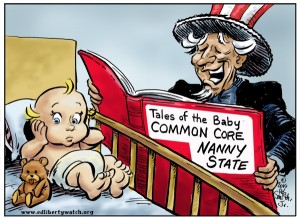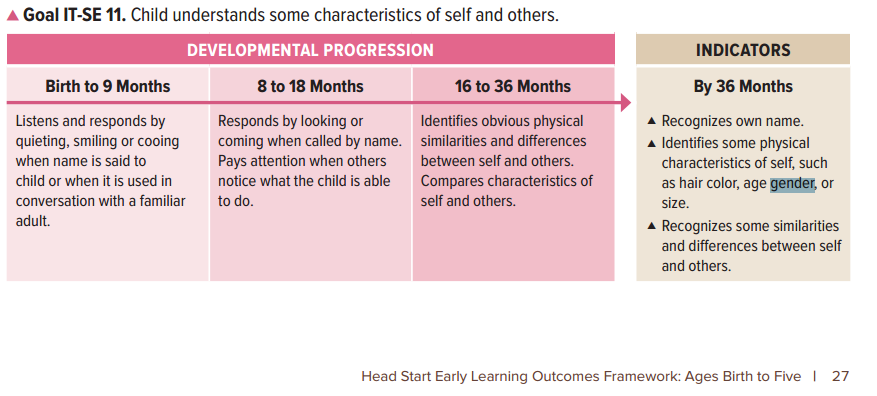New Head Start Performance Standards Cement National “Baby Common Core” Content Standards, Assessments, and Curriculum
The federal government continues its long march to ensnare more of our children in its tentacles at an ever-younger age. “Baby Common Core” has reared its ugly head.
Head Start, the failed but lavishly funded federal pre-K program, recently released its new Program Performance Standards. These standards are the yardstick by which Head Start programs nationwide will be evaluated. Chief among the many problems with these standards is the cementing in section 1302.32 of the mandate occurring 11 times in the federal Head Start Act of 2007 requiring that all curriculum be “aligned with [or “based on”] the Head Start Early Learning Outcomes Framework: Ages Birth to Five” (Framework). This Framework provides federalized “Baby Common Core”– style curriculum content standards. In fact, efforts have already been made to align both the Framework itself as well as state pre-K standards, often based on the Head Start Framework, to the Common Core national standards for Kindergarten through grade 3. So under the new Performance Standards, any Head Start program will implement Baby Common Core in order to achieve a good rating.
Addressing the 2007 reauthorization of the Head Start Act, the Race to the Top Early Learning Challenge (ELC) grants, and the harmful $250 million preschool grants in the Every Student Succeeds Act (ESSA) – grants that must be used to develop programs in compliance with Head Start — we warned of the dangers of nationalized preschool content standards, assessment, and curriculum. Particularly concerning is the intense focus on subjective and indoctrinating social emotional learning (SEL) standards. Yet that is exactly what the Head Start Act and these new Performance Standards have produced.
The controversial content standards in the Framework not only exist in Head Start programs, but are intertwined with many state preschool standards that govern private preschool programs when there is a quality rating system. According to CASEL (the Collaborative for Academic, Social and Emotional Learning), the national SEL bully, “approximately 48% of states consulted the Head Start Framework when developing their standards, and 60% of states relied on the NAEYC [National Association for the Education of Young Children] Developmentally Appropriate Practices.” The following examples explain why every parent should be alarmed with the Head Start and NAEYC standards and curriculum.
Gender Identity for 3-Year-Olds and the LGBT Agenda
Most concerning of the many problematic standards in the Framework is this set:
This standard goes beyond having children identify their biological sex, an objective physical characteristic, but rather embroils them in the complex and controversial issue of gender identity. The gender-identity issue has been central for a long time in Head Start, NAEYC, and the many state standards based on both. The curriculum Making Room in the Circle: Lesbian, Gay, Bisexual and Transgender Families in Early Childhood Settings defines gender identity as follows:
… a person’s internal, deeply felt sense of being either male or female, or something other or in between. Because gender identity is internal and personally defined, it is not visible to others. (Emphasis added.) [The same definition appears in The Policy Institutes of the National Gay and Lesbian Task Force, p. 8]
In its diversity handbook for preschool programs titled Anti-Bias Education for Young Children and Ourselves (p. 91), NAEYC identifies these goals regarding gender identity and gender roles:
- Children, regardless of gender, will participate in a wide range of activities necessary for their full cognitive and social-emotional development. (Anti-Bias Education [ABE] Goal 1)
- Children will demonstrate positive feelings about their gender identity and develop clarity about the relationship between their anatomy and their gender role. (ABE Goal 1)
- Children will talk about and show respect for the great diversity in appearance, emotional expressiveness, behavior, and gender roles for both boys and girls. (ABE Goal 2)
- Children will recognize unfair or untrue messages (including invisibility) about gender roles. (ABE Goal 3)
- Children will practice skills for supporting gender role diversity in their interactions with peers. (ABE Goals 3 & 4)
NAEYC also foments gender confusion by encouraging cross-dressing by young children (p. 93):
Some of the favorite costumes in the center are made from women’s skirts. Small slits cut just under the waistbands for the children’s arms let the skirts become super hero capes, princess gowns, doctors’ uniforms – anything the children want them to be. One morning the teacher puts out some of the costume skirts. Brad puts on the red one, but Victor hesitates. He reaches for the bright turquoise satiny one. “Is this a boy’s costume?” he asks. “Are you a boy?” the teacher responds. “Yes,” he responds soberly. “Then if you wear it, it’s a boy’s costume,” she says. Victor’s face brightens and he puts it on and with arms outstretched swirls around with delight.
Without asking why childhood innocence must be breached to discuss these issues at all, NAEYC also recommends using anatomically correct dolls to guide the conversation:
Many programs use anatomically correct dolls. Some put the dolls out for children to play with freely; others use them in persona doll stories to help children explore issues of gender identity. These stories also provide teachers opportunities to use anatomical terms in a matter-of-fact way. Sometimes a family may object to your using an anatomically correct doll with their child. If this is an issue in your program, having respectful conversations with the family can lead to a third space solution (as described in chapter 4). – p. 95
Head Start also seems more concerned about making LGBT families comfortable in its programs than about families who believe in traditional marriage. In fact, Head Start created an entire webpage about the issue titled Creating a Welcoming Early Childhood Program for LGBT-Headed Families:
One of the resources on this page contains a checklist that includes these items:
❏ Do images show people who represent diverse races/ethnicities, economic status, physical ability, age, and family structure?
❏ Do posters, children’s art, children’s book displays, and photos of your real families (including staff) depict the many ways that people work, play, and live as families?
While all children and families in these programs should be treated with respect, there is no concern for the confusion and difficulties this will bring to the majority of preschoolers by portraying these minority and very alternative lifestyles as normative. And regardless of one’s beliefs on this contentious issue, should taxpayer-funded government programs be deciding how gender identity is discussed or family structure portrayed? And what about parental rights and religious liberty?
Turning Uncle Sam into Uncle Shrink – Government-Mandated Emotional Norms
Among the other controversial Head Start standards is this set that mandates empathy in young children:
Empathy can be a highly subjective and difficult trait to assess. This and many others of these social emotional standards are expecting teachers to function as psychologists, for which they have neither the time nor the training. Even highly trained psychologists and psychiatrists and experts on preschool standards admit that there is little agreement on standards, assessment, or diagnosis based on them for young children. Additionally, gender differences would penalize boys compared to girls, because boys by their normal emotional make-up do not tend to be empathetic at that age. So boys will be more likely to receive low assessment scores, or referrals for unnecessary evaluations and treatments, for non-existent emotional problems. And of course, this subjective data would follow them for life in their government dossiers affecting “college and careers.”
Government Takeover of State, Local, and Private Preschool and Childcare
Federal law also mandates that Head Start coordinate with other federal programs such as the Child Care and Development Block Grants (CCDBG). This federal childcare law heavily promotes the Baby Common Core curriculum by strongly incentivizing grantees to implement state quality rating systems, many of which mandate these same Head Start Framework or state standards based on the Framework or NAEYC curriculum described above. This is analogous to what the federal Race to the Top grants did to impose the K-12 Common Core standards on the states. The result is a state takeover of private and religious childcare, because now these programs outside of the state system (about 80% of childcare) are being bribed or coerced to teach the public program curriculum in order to get a good rating. Minnesota admitted this in its ELC application when it said, “….to reach 3 or 4 stars requires both familiarity with the ECIPs [standards] and also alignment of curriculum and assessment with them.” (Emphasis added). Minnesota’s standards are heavily based on an earlier version of the Head Start Framework and discuss gender identity, family structure diversity, careers, and environmentalism with preschoolers. This then allows the latest Head Start Framework and curriculum to be interwoven into the state and local, public and private, preschool programs outside of Head Start.
As with the Race to the Top K-12 and Early Learning Challenge grants, the Head Start grants usurp power from states, parents, and local programs. This is federal control of academic content, designed to influence the thoughts and attitudes of our youngest children. Regardless of their positions on any particular topic, parents should be alarmed at allowing such control over their children by any government.
The K-12 Common Core standards promote social emotional goals as well, but are much less overt than the Framework. The feds were likely emboldened to directly impose national Pre-K content standards because Head Start is housed in the Department of Health and Human Services rather than the Department of Education (USED). Thus, some of the constitutional and statutory objections that parents and other citizens have addressed to USED’s overreach are less applicable to HHS (although the constitutionality of HHS as well is a valid debate to have).
Conclusion
On top of all of this, Head Start just does not benefit children. Hundreds of taxpayer-funded studies about the program have produced no good evidence that it is effective beyond third grade. That is why we support major cuts to the program this year and a major overhaul or better yet, elimination of the program in the next Congress. As stated in our recent analysis of the federal education budget, “With $19 trillion in debt, we should not be spending $430 million more [as the House is proposing] on failed preschool programs. Nor should the federal government be spending any of our hard-earned tax dollars to mold and monitor the thoughts and emotions of our children. “
Congress is now completing its work on the budget or continuing resolution that will fund the government until after the election. The fiscal year ends on September 30th. Make your voice heard. (202-224-3121)
1 Comment
Issues
- Assessments + Testing (25)
- Bullying/Sex Education (6)
- Child Protection League (2)
- Common Core Standards (78)
- Curriculum + Standards (65)
- Data Collection and Data Privacy (64)
- Early Education/Nanny State (75)
- Federal Education (128)
- International Education (6)
- LGBT Issues in Education (9)
- Media Appearances (4)
- PL/CBE (2)
- Planned Economy (11)
- Politics of Education (26)
- School Violence (9)
- Social Emotional Learning/Mental Health (52)
- State Education (89)
- Testimony/Presentations (17)
- Uncategorized (13)
- Unions (10)
Education Liberty Watch Projects
ELW Allies
- American Principles Project
- Cato Institute
- Conservative Teachers of America
- Constitutional Coalition
- Eagle Forum
- Minnesota Advocates and Champions for Children
- Missouri Education Watchdog
- Restore Oklahoma Parent Empowerment
- Stop Common Core
- The Pioneer Institute
- Truth in American Education
- What is Common Core – Education Without Representation








[…] opportunity to begin the indoctrination process with social emotional learning such as teaching three year olds about gender identity. This subjective and highly sensitive data is then put into a life-long data dossier that […]